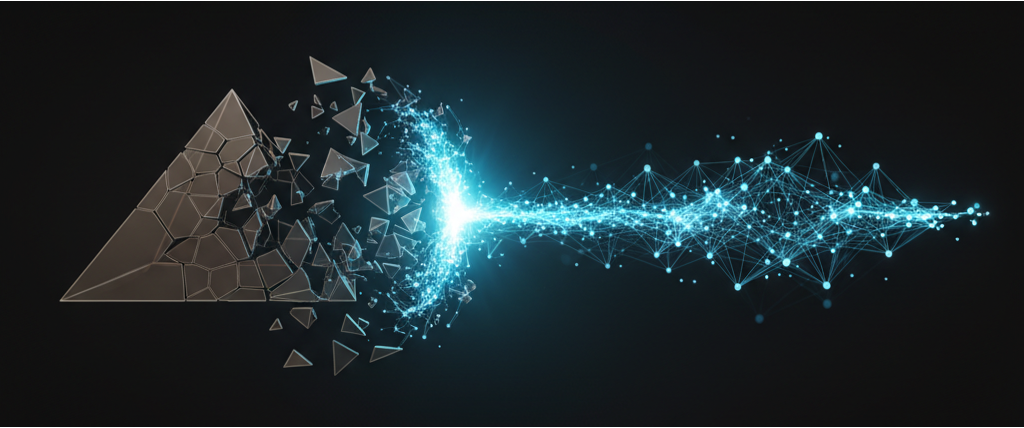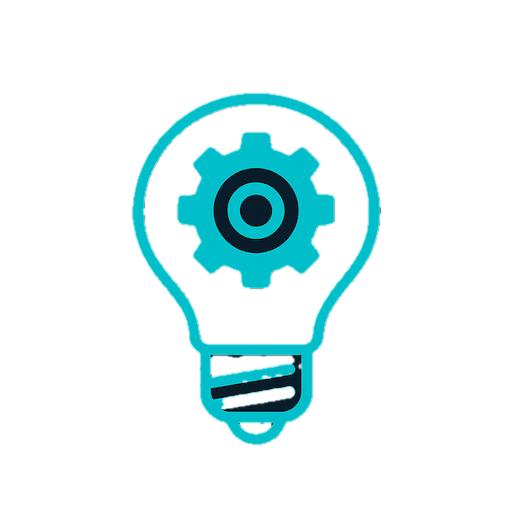AI | Future of Work | Strategy
AI and the Org Chart: Rewriting Organizational Design

The 1-Minute Executive Summary
AI is rewriting organizational design, rendering the static org chart obsolete. The new model shifts from hierarchy to holarchy—dynamic, AI-augmented networks organized by competence. Organizations must design roles as human-AI partnerships to amplify talent, flatten information flow, and achieve strategic agility and measurable EBIT impact.
The Core Mandate: Key Takeaways (Organizational Design)
The Org Chart is Obsolete.
The static symbol of fixed hierarchy is dead; winners will embrace dynamic, AI-augmented networks.
Shift to Holarchy.
Move from vertical control (Hierarchy) to horizontal alignment (Holarchy) powered by a Data Transparency Layer.
Design for Augmentation.
Don’t automate jobs; amplify talent. Structure roles as human-AI partnerships, valuing human judgment and strategic oversight.
In the age of continuous learning and Agentic AI, the organizational chart, that static symbol of fixed hierarchy, is effectively obsolete. AI is the structural catalyst that shifts the axis of power, speed, and talent. Research from McKinsey’s 2024 State of AI report suggests that organizations actively redesigning workflows around generative AI are three times more likely to report measurable EBIT impact—a stark signal that the winners of the next decade won’t just use AI; they’ll become AI-augmented. The question is no longer “How do we fit AI into our existing structure?” but rather, “What structure can only exist because of AI?”
“Organizations actively redesigning workflows around generative AI are three times more likely to report measurable EBIT impact—a stark signal that the winners of the next decade won’t just use AI; they’ll become AI-augmented.”
The disruptive force of AI operates by eliminating the need for information middlemen, dissolving functional silos, and transforming static job roles into dynamic skill portfolios. It moves the conversation past simple efficiency gains, demanding a new blueprint for the organization that can capitalize on real-time data flow and Augmentation-First design.
From Hierarchy to Holarchy: The AI-Augmented Model
The core concept being rewritten is the flow of information and decision rights. In the pre-AI era, information flowed vertically, filtered and interpreted by layers of management. Today, AI creates a shared, real-time data foundation, granting every functional team immediate access to contextualized, actionable insights. This enables a shift from rigid hierarchies (organized by control) to holarchies or dynamic networks (organized by competence and goal-alignment).
Think of it like the difference between a main government server and a Decentralized Autonomous Organization (DAO). The central AI functions as a shared, omnipresent knowledge graph, ensuring all nodes (teams, individuals, or other AI agents) operate from the same real-time truth, allowing for localized, rapid decision-making without waiting for top-down approval.
The 4 Principles of AI-Driven Organizational Design
🎯 THE ‘SUPERAGENCY’ PRINCIPLE: AUGMENTATION-FIRST DESIGN
Do not design for job replacement; design for talent amplification. Structure roles as human-AI partnerships, leveraging human emotional intelligence and strategic foresight (System 2 thinking) while AI handles routine data synthesis, content generation, and pattern recognition (System 1 tasks). This frees human capital for high-value work: complex problem-solving, ethical oversight, and radical innovation.
⚡ THE LATENCY PRINCIPLE: FLATTEN THE FLOW
Use AI to automate the work of coordination and reporting, shrinking the middle management layer from an information conduit into a strategic coaching layer. Design self-sufficient, cross-functional AI Squads. The AI brain provides the common operational context, eliminating the “latency” that kills agility.
💼 THE TALENT LIQUIDITY MODEL: SKILL PORTFOLIO
Traditional job titles shackle talent to static requirements. In an AI organization, structure is built around a dynamic skill inventory. AI tools constantly assess organizational skill gaps and recommend personalized upskilling paths and team reconfigurations in real time, making the workforce fluid and adaptable to changing market demands.
🛡️ THE TRUST ARCHITECTURE: EMBED ETHICAL AI GUARDIANS
The speed of AI can outrun human judgment, leading to bias, inaccuracy, or compliance issues. Embed AI Governance roles (e.g., AI Ethicists or Prompt Engineers) directly within business units, not just IT. This ensures that the ethical and strategic oversight is present at the point of decision, building organizational trust and mitigating risk.
STRATEGIC CHECKPOINT: The Pitfall & The Pro-Tip
The Pitfall: Automating the Mess.
The biggest mistake is applying AI to existing, inefficient processes and rigid structures. This simply accelerates your bad habits, creating Accelerated Operational Failure. You can’t put a jet engine on a horse-drawn carriage and expect a race car.
The Pro-Tip: Design for Flow, Not Function.
Before integrating a single AI tool, map your key business value streams. Identify the hand-offs and information blockages (the “latency points”) that slow down customer or product delivery. Redesign the entire organizational flow to eliminate those points, then apply AI agents specifically to automate the newly streamlined connections, not the old, broken silos.
Your Leadership Playbook
To avoid the pitfall of Automating the Mess, strategic leaders must focus on how to execute the shift from Hierarchy to Holarchy. This playbook outlines the immediate steps for organizational activation and the necessary mindset shifts.
I. Activation: 3 Immediate Executive Mandates 🚀
These are the non-negotiable actions that must be initiated before integrating new AI tools:
- 1. Mandate the Latency Audit: Direct all functional heads to map their top three value streams (e.g., Idea-to-Product, Lead-to-Cash). The primary goal is to identify all “hand-offs” and management approval points. These are your latency killers. Only after identifying and streamlining these friction points should AI agents be applied to the newly optimized flow.
- 2. Establish the Talent Liquidity Metric: Transition HR and organizational development away from tracking static “Job Titles” toward tracking “Skill Gaps” and “Skill Velocity” (the speed at which skills are acquired). This requires an immediate investment in a common organizational skills taxonomy and a platform to track real-time competencies.
- 3. Appoint the Governance Council: Create an interim, cross-functional body—the AI Governance Council—composed not just of IT and Legal, but of senior leaders from Marketing, Operations, and Product. Their first task is to define the ethical boundaries and strategic oversight protocols (The Trust Architecture) before AI is deployed at scale.
II. Mindset Shift: From Controller to Catalyst 🤔
Successfully implementing an AI-augmented design requires leaders to fundamentally redefine their role within the organization:
| Old Mindset (Hierarchy) | New Mindset (Holarchy) | Implication for AI Strategy |
|---|---|---|
| I am the Information Broker: My value is derived from controlling the flow of data. | I am the Context Architect: My value is derived from setting the shared, real-time context (the “common operational truth”) for AI Squads. | Focus on designing the AI data layer and ensuring integrity, not on filtering reports. |
| My primary role is Risk Mitigation: Control and compliance minimize deviation. | My primary role is Talent Amplification: Coaching and oversight maximize strategic foresight and human-AI partnership. | Prioritize investing in AI Ethicists and Prompt Engineers to coach teams, not just auditors to check their work. |
| We need Stability: The org chart is a fixed machine built for endurance. | We need Adaptability: The organization is a learning system built for continuous, market-driven reconfiguration. | Embrace the concept that team structures and skill requirements are dynamic, changing based on market signals captured by AI. |

The organization of the future is a learning system, not a fixed machine. It’s an ecosystem where human creativity is the scarce, high-leverage resource, constantly augmented and accelerated by an AI backbone.
Your Exclusive Actionable Toolkit
Access two powerful resources to immediately implement AI-driven organizational design.
Design Principles Summary
A PDF summarizing the 4 design principles for quick reference.
Download PDFTalent Liquidity Scorecard
A framework for assessing skill gaps and structuring dynamic, AI-ready talent portfolios.
Download ScorecardRecommended Reading:

Architect of Organizational Outcomes specializing in Agility, Innovation, and AI transformation.
Follow on LinkedIn and X for daily actionable strategies to accelerate your results.
Join the Conversation
As AI adoption accelerates, where does your current org chart most restrict the flow of value? What organizational pillar will you first re-design to build an AI-Augmented enterprise?
Share your experience in the comments below!